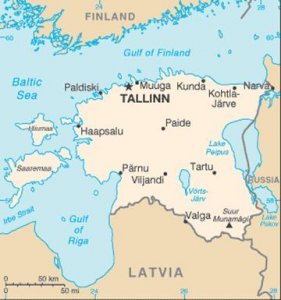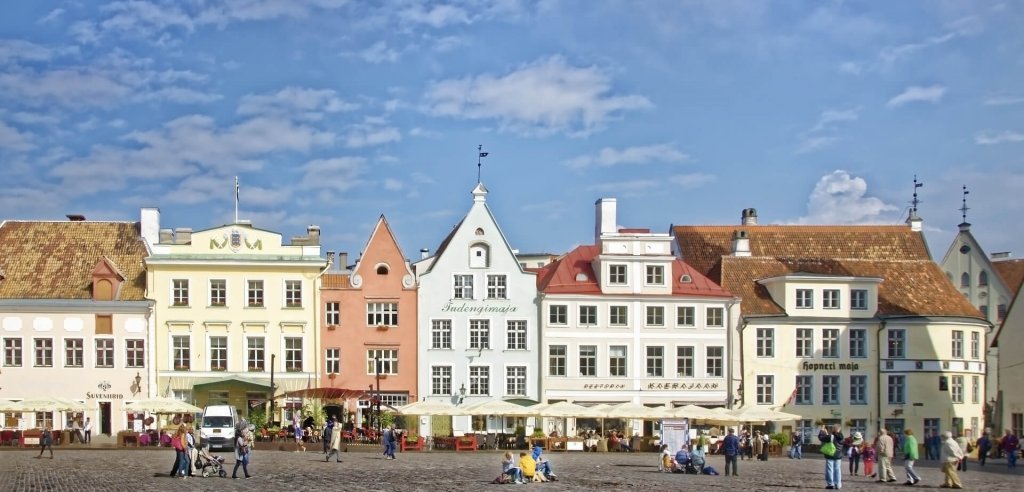
GEOGRAPHY
Estonia is the most northerly of the three Baltic States and is bordered by Russia to the east, Latvia to the south, the Baltic to the west and the Gulf of Finland to the north. Although it is the smallest of the Baltic States, about 17,462 square miles, it still has the longest coastline compared to Latvia and Lithuania. A little under 50 percent of the land is covered in forest. The inland region including the southeastern part of the country is quite hilly, while the coastal areas are mostly flat. Estonia is home to 1,400 lakes on the mainland and over 1,500 islands just off its coast. The largest islands are Saaremaa and Hiiumaa.
HISTORY

Of all the European nations, Estonia is the longest-settled. Estonians have occupied this area along the Baltic Sea for over 5,000 years. The nation remained independent until conquerors from Denmark, Germany, Poland, Sweden and eventually Russia began taking over starting around the 13th century A.D. Russia defeated Sweden in 1721 leading to the Uusikaupunki Peace Treaty, which gave Russia control over what we know as modern Estonia. It wasn’t until 1918 that Estonia attained its independence, but eventually was annexed by the USSR in 1940. Although many countries including the U.S. did not recognize this move by Russia, it wasn’t until after the collapse of the Soviet Union in 1991 that Estonia achieved its official independence. After the last of the Russian troops left in 1994, Estonia began the process of joining the Western nations. In the spring of 2004, Estonia joined NATO and the EU.
THE PEOPLE
Estonians make up a little under 70 percent of the population. Russians are the next largest group making up around 25 percent of the population, followed by Ukranians, Belarusians and Finns. Estonians, along with Finns and Hungarians, are part of the Finno-Ugric people. Estonia shares strong cultural and religious ties to other Nordic countries, as a result of centuries of Scandinavian colonization and settlement. Most people are not very religious. In fact, Estonia is considered one of the least religious countries in the world. Only around 14 percent of the population takes part in religious membership. Education is considered of great importance and the society as a whole is highly literate.
SOCIAL CONVENTIONS
Visitors should always respect the culture and heritage, which Estonians are very proud of. Normal courtesies such as handshakes when meeting someone are expected. Most people may seem reserved but are very polite.
LANGUAGES
Estonian is the official and most widely used language by about the 70 percent of the population. Many Estonians speak English too. Russian is used by some, but only around 30 percent use it.
GOVERNMENT
Parliamentary Republic
TIME ZONE
UTC + 2 – (observes summer daylight savings time)
ELECTRICITY
230V supply voltage and 50Hz
Plugs and Sockets Type C and F
CLIMATE
Estonia’s northern continental climate experiences long winters and short summers. Winter months start in November and can last into April. Snowfall may occur during this period, especially between late November to late March. Because of Estonia’s northern latitude, daylight during the winter is limited and may only be present between 9:00am to 3:00pm. Of course, the gray skies during these months also contribute to the dimness. These shorter days switch in the summer. During the summer months, the northern latitude causes longer days with daylight reaching into the evening hours. The warmest summer months are July and August. Rainfall is mild throughout the year but are heavier in these summer months, mostly as passing showers. Spring time is March to May when water levels start to rise as the snow melts. Autumn is September to October and is marked by gloomier days and rainfall.
Clothes to Wear:
The warmer months are May, June, July, August, September and October. It can rain throughout the year, so you may want a light rain coat. We usually don’t recommend traveling long distances with an umbrella. If you feel you need an umbrella, rather purchase one overseas. Pack some smart layered clothing. Even in summer it can get cool.
From November it turns colder and wetter. Snow is possible. January and February are the coldest months. Pack some warm layered clothing, a coat, gloves, warm hat and scarf. Even in the summer months of June, July and August, it can be cool some days and in the evenings. Clever layering is the key to dressing for changeable weather.
LOGISTICAL
Entry & Exit Requirements:
Estonia is a party to the Schengen Agreement. Visit the Embassy of Estonia website for the most current visa information. For US and Canadian residents who are not US or Canadian citizens (green-card-holders) with foreign passports please consult https://www.schengenvisainfo.com/ for correct European Union visa rules.
- Passports should be valid for at least six months beyond your stay.
- If you plan to stay in Estonia more than 90 days, you may apply for a longer term visa from the Consulate General of Estonia in New York (telephone 212 883 0636). In some instances you may apply for a residency permit as a student once in Estonia. You can find information on residency permits by visiting the Police & Border Guard’s website at https://www2.politsei.ee/en/teenused/ and clicking on “Services.”
- You may also obtain additional information about Estonia from the Embassy of Estonia in Washington, DC (telephone 202-588-0101).
HIV/AIDS Restrictions: The U.S. Department of State is unaware of any HIV/AIDS entry restrictions for visitors to or foreign residents of Estonia.
Embassy Locations:
U.S. Embassy Tallinn
Kentmanni 20
15099 Tallinn
Estonia
Telephone: +(372) 668-8128
Emergency After-Hours Telephone: +(372) 668-8100
Fax: +(372) 668-8267
Email: ACSTallinn@state.gov
Canada Embassy Tallinn
Toom Kooli 13, 2nd Floor
15186, Tallinn
Estonia
Telephone: +372 627 3311
Emergency After-Hours Telephone: +372 627 3311 / +372 627-3310
Fax: +372 627 3312
Email: tallinn@canada.ee
Health:
The U.S. government does not provide medical insurance for U.S. citizens overseas. We do not pay medical bills. You should purchase travel insurance before you travel.
Medical care in Estonia falls short of Western standards outside the larger cities such as Tallinn, Tartu, and Pärnu. Many medical professionals in Estonia are highly-trained, but some hospitals and clinics still suffer from a lack of equipment and resources. Many doctors speak at least some English.
Medical Insurance: Make sure your health insurance plan provides coverage overseas. Most care providers overseas only accept cash payments. Please contact your healthcare provider for more information.
We strongly recommend supplemental insurance to cover medical evacuation.
- Tick-borne encephalitis (TBE)
- Lyme disease
- Tick-borne encephalitis (TBE) and Lyme-disease are widespread throughout the country. Use CDC recommended insect repellents containing either 20% DEET, picaridin, oil of lemon eucalyptus or IR3535 to help diminish bites from ticks and other insects if you intend to visit parks or forested areas (even within parks in Tallinn). Those who will be camping or have prolonged outdoor exposure should pretreat clothing and equipment with permethrin.
- Tick-borne encephalitis vaccinations are given as a series of three doses and are not available in the United States. The vaccine is recommended for those who will be living in Estonia or those with shorter visits with extensive outdoor activities in wooded areas.
- There are no vaccines against Lyme disease.
Vaccinations: Be up-to-date on all vaccinations recommended by the U.S. Centers for Disease Control and Prevention. Like much of Europe, outbreaks of measles are frequent in Estonia and travelers should have two documented doses of MMR vaccine prior to traveling.
Information on vaccinations and other health precautions, such as safe food and water precautions and insect bite protection, may be obtained from the Centers for Disease Control and Prevention’s (CDC) hotline for international travelers at 1-800-CDC-INFO (1-800-232-4636) or via the CDC website at http://wwwnc.cdc.gov/travel. For information about outbreaks of infectious diseases abroad, consult the infectious diseases section of the World Health Organization (WHO) website at http://www.who.int/topics/infectious_ diseases/en/.The WHO website also contains additional health information for travelers, including detailed country-specific health information.
BANKS & CURRENCY
Banking hours are Monday – Friday, 9:00am – 4:00pm. The currency form in Estonia is the Euro (€).
COMMUNICATION
Telephone country code: 372
Internet country code: .ee
Cell Phone Usage:
Please contact your cell phone provider to determine whether your contract includes coverage in the country you are visiting. Depending on your contract you may have to add international services and/or country specific services.
ENTERTAINMENT
Food & Drink:
Estonian food is marked by meat and potatoes as a base. Sult (a meat jelly made from the head of a calf or pig) is a popular dish especially for holiday dinners. Smoked fish, pickled vegetables and rye bread are common amendments. Fruits and vegetables are normally included with meals as many Estonians are health conscious.
The drinking age in Estonia is 18. Beer is taken seriously and most pubs will carry products from local breweries. For those looking for an Estonian signature drink, there is a Vana Tallinn; a rum-based herb-infused liqueur. Another popular drink is Kali which is a non-low alcoholic drink made from bread.
Nightlife:
People from all over Europe choose Tallinn as a place to getaway. Finns especially enjoy the lowered price of alcohol, and the stag and hen nights are an attraction for Brits to fly in for. Thursday and Saturday nights are the most popular nights for going out. There are a variety of restaurants, bars, cafés and nightclubs featuring live bands on some nights. Other parts of Estonia including Parnu and Tartu have their bar and café scene that sees the most activity during the summer months.
Shopping:
Items that can be purchased anywhere in the world such as most electronics may be a bit more expensive here than in other parts of Western Europe. Estonia is a place to purchase locally made handicrafts which are more reasonably priced. Estonia is known for its high-quality handicrafts including embroidered Muhu slippers, carved wooden items and hand-knitted jumpers. Tallinn is a good place to discover locally produced souvenirs.
BAGGAGE
Baggage rules for international and domestic air travel have changed much in recent years, differ from carrier to carrier and these days even may cover your on-board bags. Checking luggage may cost a separate fee or may be free depending on your personal status with the carrier. We therefore encourage you to read your ticket’s small print and/or contact your carrier for exact rules.
TIPPING
Most restaurants and bars already include a 10% service charge in the bill. It is customary to leave a bit extra for good service. When the service charge is not included in the bill, 10-15% is the general rule. Tips are not expected by taxi drivers, although most people tell the driver to keep the change. Airport and hotel porters should receive the equivalent of US$ 1.00 per bag.
LAUNDRY
Most hotels will arrange affordable laundry services for guests.
PHOTOS & VIDEOS
In some countries you must refrain from photographing sites such as Military bases and industrial installations. Also be aware of cultural sensitivities when taking pictures of or near churches and other religious sites. It is always courteous to ask for permission before taking photographs of people.
USE OF DRONES
The use of drones is being legislated by many countries. In some cases, drones are already forbidden, and their unauthorized use may carry severe penalties. If you plan to travel with a drone, please contact the embassy or consulate of the country you wish to visit.
![SITA Canada Final_color [Converted]new_for_wp SITA Canada Final_color [Converted]new_for_wp](https://sitatourscanada.com/wp-content/uploads/2019/12/SITA-Canada-Final_color-Convertednew_for_wp.png)
